
The upstream sections of the gorges of Véroncle
"The trail of the Gorges is a luxury offered to the visitor to forget time, to be overwhelmed by the great outdoors, feel the harmony between nature with its harshness and the imprint of mankind living there. Landscapes which were left to us were partly shaped by human activities and reflect its genius to adapt to the constraints and possibilities of the environment. A good balance, which remains fragile!" ". Says Anne-Marie Le Mat, a former mayor of Murs, Comissionner at the Luberon RNP.
16 points of interest
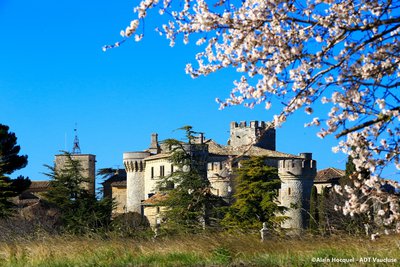
Château de Murs - ©Alain Hocquel - VPA  Patrimony and history
Patrimony and historyThe castle of Murs
It was around year 1.000 that the land of Murs is given to the Agoult family who will build a castle. For four centuries, it was mainly a stronghold for the soldiers of the lord and the dungeon was then built there. After the Agoult family, came the weapons of the Astouaud family which you can see on the castle gate. The church was built in a Romanesque style in the 12th century inside the castle. The building is private and therefore closed to the public.

Louis de Berton des Balbes dit Crillon le Brave - ©DR  Patrimony and history
Patrimony and historyCrillon le Brave, life of a warrior
At the heart of the village of Murs hides the birth house of Crillon le Brave, born in 1543. Born Louis de Berton des Balbes, he will then become Crillon and will continue to wage war. He accompanied 5 kings of France, Henri II, François II, Charles IX, the Duke of Anjou who became Henri III, and it was Henri IV, his comrade, who gave him the name Brave Crillon. His life was made of battles, wounds and victories. He died in 1615 in Avignon, a victim of his countless injuries.

Chaufferie bois-énergie de Murs - ©Hervé Vincent  Savoir-faire
Savoir-faireFirst wood fuel boiler of PACA
All of Remourase houses the very first collective energy wood boiler in the Luberon ... and even in the region! Established in 2000 during the redevelopment of a former holiday camp, it can heat 6 public housing, a lodge, a community hall and 5 local professionals. It is a renewable energy that contributes to the maintenance and the enhancement of the forest land. Since then, more than 40 boiler rooms of this type were carried out in Luberon.

Début du fossé d'effondrement de Murs - Françoise Delville - PNR Luberon  Geology
GeologyThe ditch of Murs
The village of Murs dominates to the southwest a depression occupied by farmland. These grounds fit perfectly with the limestone and clay outcrops bordered by an imposing limestone mass. About 35 million years ago, during the Oligocene, deep fractures (faults) outlined a zone which sunk gradually: a Graben (german for ditch). This is the story of the ditch of Murs, which is also the story of Sénanque ...
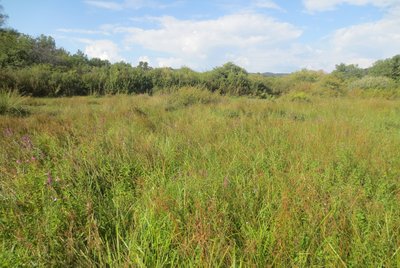
Prairies humides de Murs - ©Jérome Brichard - PNR Luberon  Water and rivers
Water and riversGrasslands of Murs
Until the late 19th century, 15ha of natural hay meadows and pastures of this valley floor were partly submerged by the dam water feeding the mills of the Gorges. Today, these grasslands are wetlands, biodiversity supports, which fill the role of water storage, purification, protection against soil erosion and the run-off of the stream. They also have an important place in the local agricultural economy which is based on livestock.

Moulin Jean de Marre I - ©Eric Garnier - PNR Luberon  Patrimony and history
Patrimony and historyThe mills of Véroncle
Since the imposing dam placed on the ponds (now filled in) from the village of Murs to the Hameau des Cortasses, about ten flour mills operated from the 16th to the mid 19th centuries. Despite the places hard to reach, following along the ravine are amenities of a rare quality,: penstocks and channels carved in the rock, reservoirs and retaining walls.

Genêt de Villars - Laurent Michel - PNR Luberon  Flora
FloraSmall garrigue (scrubland) in Genêt de Villars
On this arid hillside, you can see a discreet broom (shrub) against the ground: Villars broom (Genista pulchella subsp. villarsii). Its meagre look is an adjustment to sunny and dry environments: It sweats very little! While fearing competition from other species, he deigns to share its habitat with few neighbours hand-picked, like here, Perennials (Minuartia capillacea) family of carnations with beautiful white flowers.
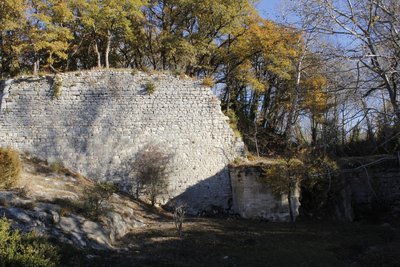
Ruines du barrage des étangs - ©Jérémie Haye - PNR Luberon  Patrimony and history
Patrimony and historyThe dam of the pond
Built in the 16th century, This large tank was used to supply the first three mills of the Gorges belonging to the Lord of Murs. It also served as a fishing reserve. Remodelled several times over the centuries, it no longer works nowadays but remains in place. Two parallel walls 80m long held back a pile of earth forming a earth-fill dam. On a quoin, we can see a badge dated 1584 which could be a date of remodelling of the building.
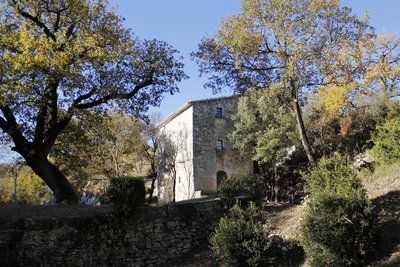
Moulin des étangs (habitation privée, ne se visite pas) - ©Jérémie Haye - PNR Luberon  Patrimony and history
Patrimony and historyMoulin de l'Etang
First mill of the Gorges and located on the lands of the Lord of Murs, the current building was probably built in the 16th century, as evidenced by the date 1581 on the lintel of a door. It was probably enlarged in the 18th century and more recently converted into a private housing. Initially, it operated with an horizontal wheel turned into a vertical wheel at the end of the 19th century. It was fed by a resclause (small reservoir upstream) located near the old pond.
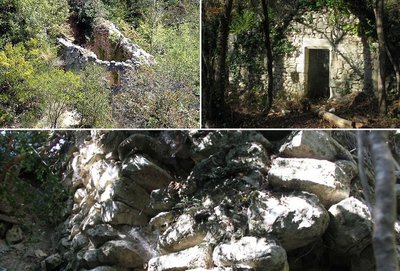
Vestiges du moulin du Dévissé - ©Eric Garnier - PNR Luberon  Patrimony and history
Patrimony and historyMoulin du Dévissé
It is the second mill of the Gorges in Murs. Also built in the 16th century as indicated by the year 1573 engraved on a stone from the entrance door, it is now in ruins. It was fed by a béal (channel) which is none other than a leak of the mill of the pond. Today, we can only make out the grinding room which is in flint. Below stood the water chamber today obstructed, and above, the dwelling of the miller.
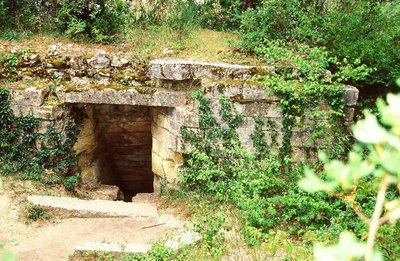
La canon en pierre de taille - Jérémie Haye - PNR Luberon  Patrimony and history
Patrimony and historyMoulin de la Charlesse
The third mill of the Gorges in Mursit is based on the same construction principle as the first two (a water chamber which is under the grinding room and the dwelling). The year 1753 is engraved on a stone corresponds most likely to the year of remodellingthan the initial construction. Here, we can easily distinguish the cannon in ashlar stone which allowed to create a waterfall and so a driving force between the resclause (small reservoir upstream) upstream and the water area below.

Gorges de Véroncle - ©Eric Garnier - PNR Luberon  Geology
GeologyGorges de Véroncle
The water flow between the collapsed ditch of Murs located on the heights of the limestone plateau and the Apt basin downstream, dug this impressive canyon called "raccordement". Then the corrosive action of rain water containing carbon dioxide has gradually, through dissolution, enlarged cracks to create true underground networks. The Gorges de Véroncle are not used or hardly used by water, but contain an amazing industrial heritage.

Véroncle en crue ! - ©David Tatin  Patrimony and history
Patrimony and historyMillers of all trades!
As of the 19th century, the lack of water and the inability to operate the mills of Véroncle more than two months in the year are being noticed. So to adjust to this, millers had to find other sources of income. This is how they started small farming units, mixed farming, firewood or silkworms! And when water would refuse to flow well in the Gorges again, the millers would return for a while to their milling business.
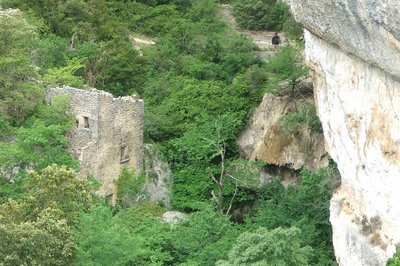
Moulin Jean de Marre I - ©Eric Garnier - PNR Luberon  Patrimony and history
Patrimony and historyJean de Marre I mill
It is the first mill of Gordes. Built in the 16th century, it was expanded in the 18th century, as evidenced by the collages of masonry. It is a more complex construction on 4 levels: the water chamber, the grinding room, the sack floor and the dwelling (you can still see a fireplace and a sink). In the 19th century, an independent farming developed with arable lands, vineyards, mulberry trees, olive trees, almond trees, pigs, chicken coops.

Cascade de tuf - ©Georges Guende - PNR Luberon  Flora
FloraThe tuff waterfall
The waterfall, where the Jean de Marre I mill was strategically located forms also a beautiful natural curiosity called tuff! Product of dissolved limestone redeposited, having captured plant and animal debris, the tuff is a very tender and friable rock. When the river is not dry, it is home to lush mosses and ferns particularly enjoying the saturated humidity of the place. This habitat is still rare and located in Provence.
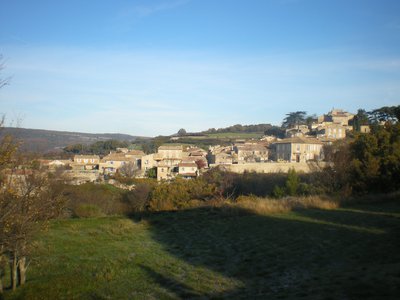
Village de Murs - ©Françoise Delville - PNR Luberon  Panorama
PanoramaHere, time stops...
Between Ventoux and Luberon, this wooded limestone massif opens onto rare agricultural parcels. Contemporary human presence is discreet but the wealth of the dry stone heritage is a reminder of its historical presence. A network of winding roads and ancient mule tracks serve the hilltop villages alongside the massif. These roads, dotted with remarkable oaks, reinforce the bucolic character of this countryside that seems frozen as if it was timeless.
Description
At the entrance of the village, at the junction of the D4 and D15, take the little road going down which is across the school yard. Leave the village, take a beautiful hairpin bend, then lower (point 447) take the track across. 700m further, do not miss the start of the trail to the right (PR). Go down two rocky switchbacks, pass the ruins of the old dam and the mill ponds, then continue to the valley bottom. Pass the Devissé windmill and continue going.
1 - In front of the ruins of the Charlesse mill and its penstock, rise right on a rocky path that winds around the foothills of the Gorges (PR). Switch to the left over the undergrowth and turn left at the intersection of a trail.
2 - At the intersection ''Vezaule'', continue left the balcony trail. After four hairpin bends, come out at the bottom of the Gorges.
3 - Make a short back and forth to the right to see the Jean de Marre mill located just downstream, then go up some thirty meters upstream to a rocky slab. Do not climb the steep path to the right but continue on the one that runs along the river bed. 200m further after a small leap, cross a ford, take the path on the opposite bank in the downstream direction. Climb two stony steep paths, reach the old track and continue climbing the milder slope. Reach the plateau and continue the path until the track.
4 At the crossroads "Lauzière'', turn left and follow the trail. Pass two curves and the entrance to the campsite and continue on the small road of Bois d'Audibert. At the crossroads just after the entrance to the vacation center, go left. Reach the D4 (calvary), turn left and reach the heart of the village of Murs.
- Departure : Outside the town hall of Murs
- Arrival : VIllage of Murs
- Towns crossed : Murs and Gordes
Forecast
Altimetric profile
Recommandations
Caution with your ankles and some of the steep, rocky or stony passages.
Before point 1 and point 3: ravine bottom passages that can be tricky after a big storm.
Information desks
Luberon UNESCO Global Geopark
60, place Jean Jaurès, 84400 Apt
House of the Luberon Regional Nature Park
60, place Jean Jaurès, 84400 Apt
In the heart the old town centre of Apt, the House of the Luberon Regional Nature Park welcomes you in a town house of the 18th century. The permanent exhibition of the geology museum has a rich collection of fossils evidencing the geological history of the Luberon.
On sale at the shop: books, maps, guidebooks, games, posters...
Open Monday to Friday from 8:30 am to 12:00 pm and from 1:30 pm to 6 pm (and on Saturday, depending on the program). Free admission.
OTI Pays d’Apt Luberon
788 avenue Victor Hugo, 84400 Apt
Du 1er avril au 30 septembre
Ouvert du lundi au samedi de 9h30 à 12h30 et de 14h à 18h.
Juillet et août : Ouvert dimanche et jours fériés de 9h30 à 12h30
Du 1er octobre au 31 mars
Ouvert du lundi au mardi et du jeudi au samedi de 9h30 à 12h30 et de 14h à 18h.
Fermé le mercredi, dimanche et jours fériés.
Access and parking
At 17km from Apt through the D4 and D2.
Parking :
More information
Source

Report a problem or an error
If you have found an error on this page or if you have noticed any problems during your hike, please report them to us here:



